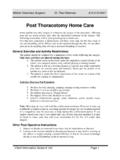Transcription of Post Surgical Care of Cruciate Ligament Rupture …
1 Mobile Veterinary Surgeon Dr. Paul Newman 615-519-0647 Client Information Series # 72 Page 1 Post Surgical care of Cruciate Ligament Rupture Repair In Cats Home patient care after orthopedic surgery is critical to the success of the surgery. Allowing your pet too much activity may alter the anticipated outcome of the surgery. Remember, a ruptured Ligament is a severe orthopedic injury and although surgery is necessary to reduce future arthritis and minimize pain and healing time, the joint will never be good as new.
2 The following instructions will be your guide to home care . Week 1: 1. Provide pain management with NSAID s the first five days 2. Apply an ice-pack to the stifle (knee) for 10 to 15 minutes two to four times a day for the first 24 to 36 hours after surgery 3. If inflammation has resolved after 72 hours, apply a hot-pack to the stifle for 10 to 15 minutes two or three times a day 4. Perform passive range of motion exercise (gently flex and extend the knee); 10 slow repetitions three times a day 5. Precede and follow the passive range of motion exercise with massage of the quadriceps muscles (large muscles above the kneecap) 6.
3 Keep your cat indoors confined to a small area or room with no running, jumping, or playing. Weeks 2 & 3: 1. Apply a hot pack to the stifle for 10 to 15 minutes two or three times a day until the swelling has resolved 2. If you notice your pet s pain level getting worse after the last pain medication, please call and ask for a refill 3. Stop passive range of motion exercise if your cat is using the leg correctly 4. Increase activity by allowing your cat to move about the house but keep indoors 5. Continue massage 6.
4 Schedule a recheck with your doctor 2 weeks after surgery to remove any sutures and evaluate range of motion, limb girth, and percent weight bearing 7. Most patients begin to bear some weight by week 3, but every pet is different and some may take longer Weeks 4 & 5: 1. Outdoor activities are allowed if you can keep your cat on a harness or collar and long leash Mobile Veterinary Surgeon Dr. Paul Newman 615-519-0647 Client Information Series # 72 Page 2 2.
5 No indoor restrictions at this time Weeks 6 8: 1. Schedule another recheck with your doctor six weeks after surgery to evaluate your cats progress 2. If your cat is full weight bearing at this time, all restrictions will be removed 3. If there is still some residual lameness, further restrictions will be needed Weeks 9 12: At this point, your pet s healing should be complete and should gradually return to full activity by the end of 12 weeks with no indoor or outdoor restrictions. Additional Instructions: 1.
6 Licking at the incision should be discouraged because it may lead to chewing at the sutures or staples causing a wound infection. It may be necessary to bandage the leg or use an Elizabethan collar to prevent licking. 2. Bandages, if used, should always be kept dry and clean. Any odors and/or persistent licking are indicators that there may be a potential problem and should be checked by your veterinarian immediately. Bandages and splints should be checked weekly by your veterinarian or veterinary technician. 3. Feed your cat its regular diet but reduce it by 10% to allow for reduced activity.
7 4. Mild swelling may occur near incision or low on limbs. Your veterinarian should check moderate or severe swelling immediately. 5. Use of a joint protective supplement with glucosamine and chondroitin is highly recommended for at least six months if your pet does not have arthritis. If your pet does have arthritis, it is recommended to use this supplement for the life of your pet. Although there are over twenty brands of this nutraceutical, Dasuquin is the best supplement you can use. Cosequin is the next best.
8 Complications As with any Surgical procedure, complications can occur. Unlike human patients who can use a sling or crutches, our patients do not know enough to stay off a healing Ligament so restricted activity is a major responsibility of you, the pet owner. Failure to follow these instructions carefully can lead to delayed healing or even Rupture of the new artificial Ligament . The most common complication is delayed healing, where, despite our best efforts to stabilize the joint, individual patients respond slower than others.
9 On rare occasions, especially in large muscled patients or patients with injuries several months old with severe swelling, the peroneal nerve which provides sensation to the top of the paw Mobile Veterinary Surgeon Dr. Paul Newman 615-519-0647 Client Information Series # 72 Page 3 and controls the muscles that flex the paw can be inadvertently injured. If your cat seems to have serious leg pain or loss of sensation with foot dragging immediately after surgery, please notify me right away.
10 If you have any questions, please feel free to ask your veterinarian or call me at the number above. Your pet had the following procedure(s) done: *Cleaned out torn Ligament remnants, inspected the cartilage (meniscus) and flushed out the joint *Examined synovial lining of the joint for evidence of autoimmune (immune system attacks it s own tissue) inflammatory disease. Biopsy recommended: yes / no / hold *Performed a meniscal release procedure to prevent future tearing of the cartilage *Removed torn or damaged medial/lateral meniscus cartilage *Debrided and removed osteophytes around joint surfaces *Imbricated (tighten) the joint with sutures to help stabilize the joint *Placed a single / double lateral / medial Fiberwire / Nylon suture to replace the torn Ligament and stabilize the joint *Injected Marcaine (local anesthetic) in the joint *Injected Adequan IA (joint protectant)












